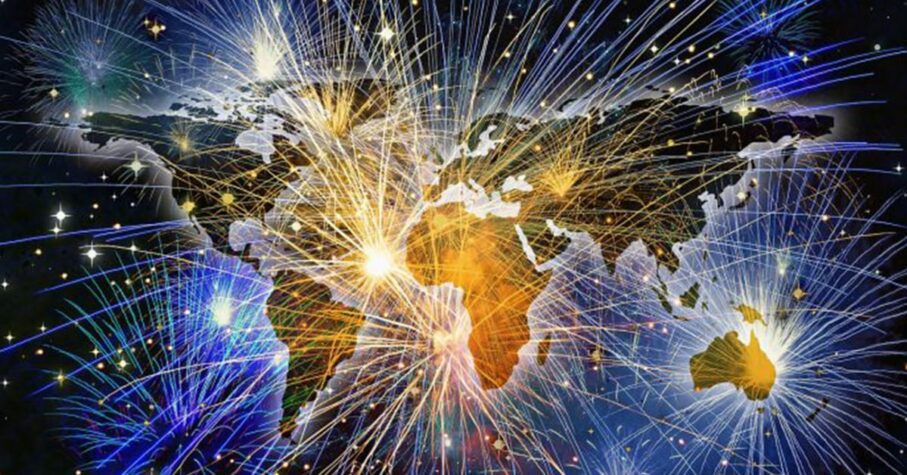
By Jonathon Engels | Green Global Travel
Did you know that more people celebrate New Years around the world than any other holiday? But, of course, that doesn’t mean that we all celebrate it in the same way. How I celebrate the New Year– watching the NYC countdown on television, kissing at midnight, champagne toasts, and fireworks– may be relatively commonplace in the United States and Canada. But New Year customs vary widely in different cultures around the world.
Each country seems to have its own unique New Years celebrations, with different customs for ensuring health, wealth, happiness, and luck in the coming year. As we learn more about the various New Years celebrations around the world, we may discover strange cultural twists that seem foreign to us. But these unique variations in the way people celebrate the New Year are part of what makes exploring the world so great.
So let’s take a look at some of the more interesting New Year traditions around the world, and see how people will be ringing in 2020. Who knows? Maybe we can find something fun along the way to adopt into our own New Year celebrations. I know many of us can’t wait to bid 2019 good riddance. So get ready, because New Years Day is coming soon!
HOW TO CELEBRATE THE NEW YEAR AT HOME
The home plays an important role in many countries’ New Year’s traditions, which can involve everything from intense cleaning sessions to inviting special guests. Regardless of how it’s done, home is where many people celebrate New Year’s Eve and Day.
England: For good fortune in the newly arrived year, Brits believe the first guest to enter through the front door should be a young, dark-headed male bearing gifts such as bread (to be full), salt (to be wealthy) and coal (to stay warm).
Japan: Oshogatsu is celebrated with family, which both cleans and decorates the entire house together. Then natural decorations such as pine branches, plum blossoms, and bamboo play a special role in preparing for the New Year celebration.
Denmark: As a sign of friendship, people save their old dishes in order to break them on each other’s front doors. Residents will allow these broken dishes to pile up in order to show who has the most friends.
China: To symbolize happiness and good luck in the New Year, Chinese celebrants paint their front doors red. In general, red colors New Years Eve in China, with red packets of money for children, red rackets for married couples, and red lanterns.
Puerto Rico: In addition to cleaning their homes as the Japanese do, Puerto Ricans clean everything— the car, the garden, and even the streets. They also have a practice of throwing buckets of water out the window in order to do away with the bad juju of last year.
South Africa: Some South Africans—particularly those in the neighborhood of Hillbrow in Johannesburg— take cleaning house for the new year to an entirely new level. Throwing old furniture and appliances (think fridges!) from the windows of tall buildings somehow helps to make the new year bright. It’s actually a very serious health hazard there!
CELEBRATE WITH NEW YEAR’S EVE FOOD TRADITIONS
Food is used to celebrate the New Year around the world. In many countries, eating the right thing has a strong influence on the next year’s outlook. Many of these New Year’s food traditions are delicious, but they don’t necessarily make a lot of logical sense…
Louisiana: The New Year’s food tradition I grew up with is eating Cajun-style black-eyed peas and cabbage, with the promise that it will deliver health and wealth over the next 12 months. Even after 12 years of living and working abroad, I’ve never stopped celebrating the New Year with the dish!
Brazil: Lentils are the alimentos do dia for Brazilian New Year’s celebrations. The legume can come in different forms, such as soup, to help with finances in the New Year. Then, before midnight, they believe people should also eat seven raisins (because why not?!).
Austria: The New Year’s food traditions in Austria come two-fold. First, there’s finding a lucky charm that has been hidden inside a suckling pig. Then it’s onto a dessert of peppermint ice cream, which somehow represents economic windfalls in the coming year.
France: The French are known for their weird food preferences. On New Year’s Eve, edible opulence steals the show in the form of le reveillion de la Saint-Sylvestre. Partiers will feast for hours on foie gros, goose or turkey, oysters, and of course plenty of champagne. The top-flight fare is meant to signify wealth in the year to come.
Spain: A challenge in speed-eating, Spain’s New Year’s food tradition requires that people eat 12 grapes at midnight on New Year’s Eve– one for each time the clock chimes. Otherwise, superstition suggests that you’ll miss out on extra good luck for the coming year!
Switzerland: In a strange cultural twist, the Swiss don’t actually eat their New Year’s treat. Instead, they simply drop whipped cream on the floor and leave it there. Obviously, that means richness in the coming year, right?
Estonia: How Estonians make it to midnight on New Year’s Eve awake is a mystery. They should be in a food coma! Tradition dictates that the holiday should be celebrated with a lucky number of meals, with either seven, nine, or twelve trips to the table. However, many meals you choose, you’re said to have the strength of that many men (or women).
NEW YEAR’S FESTIVALS AROUND THE WORLD
Some of the world’s New Year’s traditions have an air of seriousness about them. They’re tied up in ancient religious rituals. They’ve been created by lawful decrees. Or maybe they just involve impressively huge fires in public spaces. Regardless, it’s important to recognize why we celebrate the New Year the way we do.
Scotland: Celebrating Hogmanay, which denotes the last day of the year, is a big deal in Scotland. So much so that it often overshadows Christmas. Christmas was outlawed by the Church of Scotland for nearly four centuries, until 1958. Though the holiday has regained its popularity, the New Year Festival of Hogmanay still holds a sacred place in Scottish hearts.
Australia: Sydney Harbour hosts one of the biggest New Year’s Eve celebrations in the world. It’s mid-summer in the southern hemisphere, and thousands of people gather around the Opera House in anticipation. An aerial show and water display kick off the celebration at 6pm. A family-friendly fireworks show starts at 9pm, while the main attraction– the Harbour Light Parade– is at midnight.
Belarus: In Belarus, New Year’s is included as a part of a 13-day festival known as Kaliady. Kaliady originates from the old pagan recognition of the winter solstice. It was only later that the Orthodox Christians added the celebration of Christmas (on January 7). Kaliady has customary foods in three ritual dinners, trick-or-treating, caroling, and more.
Netherlands: Amsterdam hosts one of the world’s largest street parties on New Year’s Eve. If you attend, buy some oliebollen (oily balls) to eat at midnight. Tradition holds that eating these deep fried dough balls will ward off evil spirits in the New Year. Dam Square (the craziest), Rembrandtplein, Nieuwmarkt, and Leidseplein host unofficial street parties with music, fireworks and beer tents. Amsterdam’s celebration is not for the casual partier: Some attendees have likened it to a war zone!
United States: Each year, hundreds of thousands of people flock to New York City to see the Big Apple drop at midnight. This New Year’s Eve tradition actually began as a replacement for fireworks, which had been banned in New York. In addition to watching balls drop, in other US cities you can watch peaches, giant walleye, and other locally relevant symbols lowered as the clock strikes midnight.
SINGING THE NEW YEAR SONG, “AULD LANG SYNE”
Singing “Auld Lang Syne” at midnight is done throughout the English-speaking world and beyond. The traditional Scottish folk song was transcribed (not written) by beloved poet Robert Burns in 1783. The literal Auld Land Syne translation is “old long since,” which really means, “days gone by.” After that, it became a common song of celebration—for weddings, graduations, funerals, etc.—throughout Scotland. In the nearly two and a half centuries since, “Auld Lang Syne” has become the most popular New Year’s song in the world.
The tradition of singing it at midnight on New Year’s Eve was popularized by a Canadian band, Guy Lombardo and the Royal Canadians. The band, which came from a part of Ontario settled by Scots, often covered the song, partially to promote one of the sponsors of their radio show, Robert Burns Cigars. In 1928 the band got a chance to do a New Year’s Eve show and closed their set with “Auld Lang Syne.” It became the show’s closing number for nearly 50 years, the remainder of Lombardo’s life.
By Jonathon Engels | Green Global Travel
NB: This article may have been edited and/or condensed. The information contained is as of date of publication and may be subject to change. These articles are intended as general information only.







